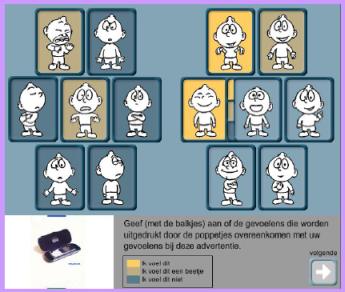MEASURING ADVERTISING EMOTIONS
Advertisers like to elicit emotions with their advertisements, because (positive) emotional responses lead to higher appreciation and persuasiveness of those ads. But how should one measure whether ads evoke the desired emotions? The Technical University Delft (TU) recently developed a new research instrument, called PrEmo, designed to measure emotions towards products and packages. A study by the Radboud University of Nijmegen shows that PrEmo is also useful in an advertising context.
 (Pr)Emotions PrEmo measures positive and negative emotions using 14 animations. Each animation depicts a separate emotion through facial and bodily expression, and tone of voice (Desmet 2000). Seven positive emotions (desire, pleasant surprise, amusement, admiration, inspiration, satisfaction and fascination) and seven negative emotions (disgust, indignation, disdain, unpleasant surprise, dissatisfaction, disappointment and boredom) are scored on a three-point scale, without making use of any verbal labels. PrEmo has advantages over existing (non-verbal and verbal) research instruments: emotions are measured directly, consumers hardly take any cognitive steps and PrEmo is suitable for intercultural research and large samples.  Study We examined whether PrEmo is sensitive enough to register subtle differences in emotions evoked by advertisements. PrEmo had to meet with five criteria in order to be judged fit to be applied in an advertising context: (1) The emotions measured by PrEmo are relevant for advertisements; (2) PrEmo measures differences in emotions between advertisements in the predicted direction; (3) The emotions measured by PrEmo show a positive relation with appreciation; (4) The emotions measured by PrEmo are highly predictive of the persuasiveness of the advertisement; and (5) PrEmo is judged as user-friendly. Method In order to test PrEmo, six open advertisements were selected for the experiment. In the last decades the number of open advertisements has increased. Open advertisements provide less guidance toward a certain message, requiring consumers' effort to construct an interpretation. Because consumers want to avoid this effort, they appreciate open advertisements less than closed ones. Since emotion is strongly correlated with appreciation, one might expect that open ads score lower on positive and higher on negative emotions. The advertisements of four car brands (Volkswagen, Mercedes SL, Lexus GS300 and Toyota RAV4) and two mobile phones (Nokia 8810 en Nokia 3330) were selected for the experiment. Three conditions were made for each ad: an open condition without a headline, an moderate guiding condition with a headline that contained a verbal cue and a closed condition with a headline explaining the ad's message. If PrEmo is a suitable instrument to be applied in an advertising context, it should be able to measure differences in emotions as a result of the subtle variation in openess between the conditions. The respondents were divided into six groups and were confronted with three advertisements. They received the PrEmo CD-rom at their homes. Appreciation, persuasion and user-friendliness were subsequently measured using a questionnaire. 1300 Participants from the TNS NIPO data base were approached from which 74 percent responded.  Results Desk research showed that PrEmo emotions have frequently been used in research on commercial messages and are therefore well applicable on advertisements. In that sense the PrEmo emotions contribute to the mutual understanding and the language-use about emotions between advertisers and product developers. After all, misunderstanding exists about the nature of emotions and how they should be measured. Moreover, PrEmo measures the differences in emotions between all conditions in the expected direction. Respondents scored higher on positive emotions in case of closed ads and higher on negative emotions in case of open ads. The PrEmotions corresponded well with appreciation; higher appreciated advertisements evoked more positive emotions. PrEmo predicted the persuasive power of the tested ads in a reasonable way; advertisements that elicited positive emotions were found more persuasive than advertisements that elicited negative emotions. However, appreciation measures predicted the persuasive power somewhat better than the PrEmotions. Finally, respondents judged PrEmo as user-friendly. About half found it (very) enjoyable and (very) easy to work with PrEmo and only 20 percent found it not so enjoyable and easy to use. These scores correspond well with previous PrEmo research on packaging and products.  Conclusion PrEmo, originally developed to measure emotions elicited by products and packages, is also suitable to measure specific emotions elicited by advertisements. This instrument has some major advantages in respect to existing research tools for measuring advertising-emotions. It clarifies to what extent a particular ad is able to elicit emotion ('arousal'), regardless the direction of the emotion. Contrary to hart rate and galvanic skin response registrations, PrEmo also measures the average positive and negative emotion scores, which makes the direction of these emotions obvious. And finally, 14 specific PrEmo emotions are registered. The latter proves to be vital information since many ads are designed to elicit specific emotions. For marketers it becomes possible to influence the effectiveness of the communication messages. Based on emotional profiles they can further specify the socio-demographic characteristics of their target groups. PrEmo provides more certainty and clearness about the amount of arousal and kinds of emotions that products and commercial messages evoke. Due to its attractive visual character, consumers hardly have to take cognitive steps and emotions can be measured fast. PrEmo is an intercultural tool, suitable for large samples and easily applicable on the pc at home or in another setting.  |
Ketelaar, P. E., Gisbergen, M. S., & Hentenaar, F. (2005). Meten welke emotie je oproept.Tijdschrift voor Marketing, 3(39), p.56-58.
|
|